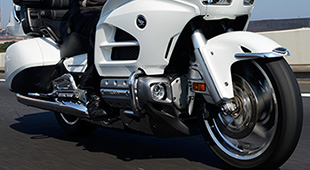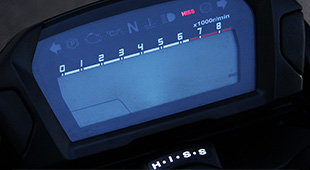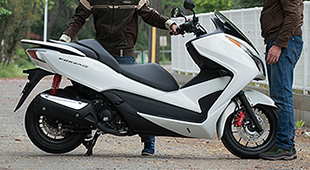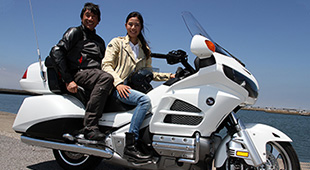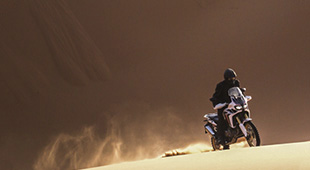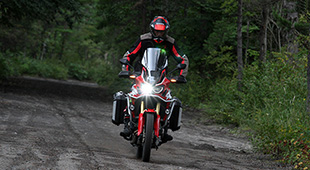Tech Views — Vol.8 CRF1000L Africa Twin
Development Story (1/5)
Charging Ahead with the Passion of Youth to Create the Ideal Africa Twin
What I can do is show you the 'Door to Adventure'
Many dangers lie beyond this door,
But only you can open it.
I can take you there, if you wish.- Thierry Sabine -
A Dream Named 'Adventure'
As Seen by a Young Team of Engineers
The 'adventure' spoken of by Thierry Sabine, founder of the Paris-Dakar Rally, has many different meanings, but motorcycles are always found in close proximity to this word 'Adventure.' "Adventure? Yes, I love it. Doesn't every boy share a love of it? However, the adventure I'm talking about is not only one of trekking to the ends of the earth or visiting unexplored regions. Instead, adventure could entail such simple things as riding your bike off a well-travelled highway onto a small side road for the first time, or over a bumpy road," says Yutaka Yamakura of Honda's Motorcycle R&D Center, who was put in charge of the Africa Twin's chassis and bodywork design. He talks cheerfully, with a big smile on his face, perhaps because he's imagining riding a motorcycle, especially off-road. As a matter of fact, Yamakura is a 'key man' who played a vital role in the development of the new Africa Twin from its initial stage of development, creating its concept and determining its direction based on its predecessor model.
Back in high school, Yamakura had been fascinated by dreams of 'adventure,' as described by Paris-Dakar Rally founder Thierry Sabine.
Yamakura — "When I was in junior high school, the Paris-Dakar Rally was just starting to be televised. I watched that program many times, and the images I saw were absolutely riveting. There were many TV programs about the Paris-Dakar Rally, but mostly they focused on the cars in the competition. Instead, what I really wanted to see were the bikes racing in the 'motocross division.'
"At first I was amazed to see them racing at top speed over such harsh terrain, thinking, "Wow! How can they race in a place like that on a bike?!" Soon, I began taking a deeper interest in the motorcycles themselves, and eventually learned about a bike called the NXR. It was a Honda Works machine, solely intended for racing in the Paris-Dakar Rally. As time went on, I became infatuated with the big off-road bikes, and even rode around on an Africa Twin that I'd bought myself when I was a university student. That was one of the reasons why I chose Honda as the company I wanted to work for."

Wanting to Create a New Africa Twin
The Africa Twin was still in the Honda lineup when Yamakura joined the company. Holding out hope of someday making a new Africa Twin, and dreaming of taking charge of its development, Yamakura continuously talked about creating a new Africa Twin within the company. However, production of the Africa Twin ended only a few short years after he joined Honda.
Yamakura — "The end of the Africa Twin's production left Honda with no large-displacement dual sport models in its lineup. From then on, I agitated for developing a new Africa Twin every chance I got."
As a result of this personal campaign, when the development project for a new dual sport model finally began, Yamakura was selected as one of the team members. His chance had come at long last.
Riding Enduros on the Africa Twin.
Waves of Enthusiasm Begin to Grow.
As Yamakura speaks animatedly about the project, Akihiro Iida smiles quietly, like an older brother. Iida has long been deeply involved in engine development at Honda's Motorcycle R&D Center.
Iida — "I was really eager to go racing when I first joined Honda. Frankly, what I really wanted to get into was F1. Although I'd ridden motorcycles back in my school days, I didn't have any special preference for them. When I first joined the company, I was assigned to the motorcycle division, but I soon asked to be transferred to HRC (Honda Racing Corporation) because I still wanted to do something in racing. I was surprised and delighted when the company granted me that wish. Since then, I've been put in charge of the development of many different categories of engines."

At HRC, Iida took charge of the design of such engines as air-cooled singles and advanced 4-stroke engines for Trials bikes, as well as race engines for the Suzuka 8 Hours World Endurance Championship and Moto GP machines. Having played a central engineering role in these creations, Iida was selected to join the development team for the new Africa Twin.
Iida — "I have no idea why I was assigned to the Africa Twin development team. When I joined the team, I had so little knowledge of what the Africa Twin was that I had to ask, 'Africa Twin? Isn't that some kind of big off-road model?'"
Yamakura explains the reason. "The team needed an engine design specialist who is capable of designing small and lightweight engines from scratch."
As the leader in charge of the new machine's overall chassis and body design, Yamakura called on Iida as an expert in engine development. Besides Iida, other 'Big Off-Road' enthusiasts were also recruited from within the company to focus their efforts on researching structural strength and riding stability issues. The new project started off with discussions about what the Africa Twin was, and what the new Africa Twin should be.

Next, as a representative of the development team, Yamakura started riding his own Africa Twin in the company's in-house enduro races. Competing against other smaller displacement models such as the XR100, CRF250L and XR250, his big Africa Twin finished the races in style, impressively showing off its riding ease and confident control.
Yamakura — "I told the other team members I'd selected that, 'This is the sort of bike we want to make. Isn't it great?' I'd like to think they all came away with a better understanding of the Africa Twin's many great features. I explained, 'Let's recreate this using today's technologies! If we do it now, we can make a new Africa Twin entirely from scratch, with no need to think about carrying over existing components.'"
Yamakura's enthusiasm gradually began to spread to the others around him.
- Top
- History
- A New Era
- Technical Points
- Development Story

